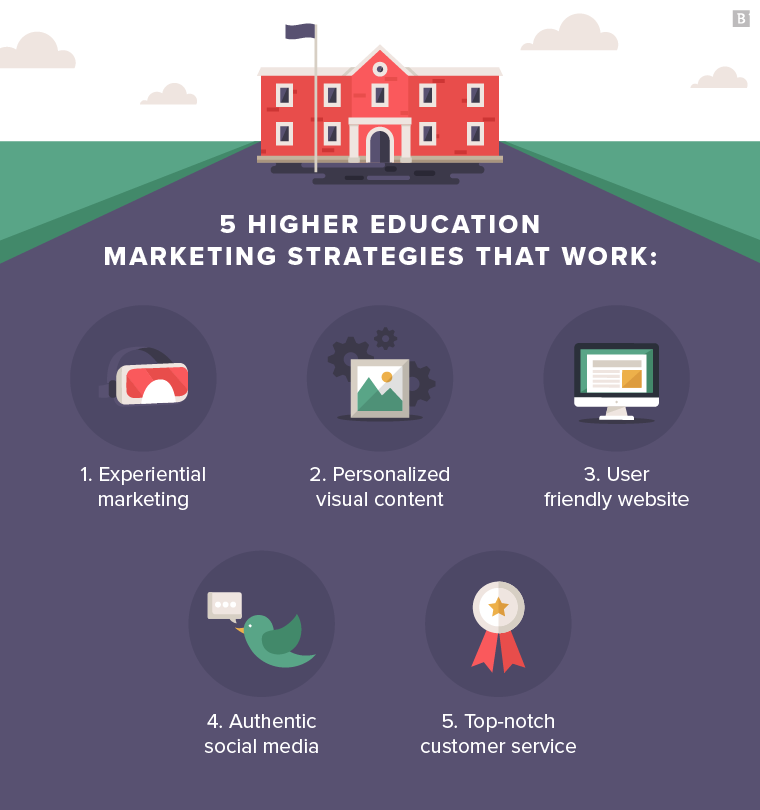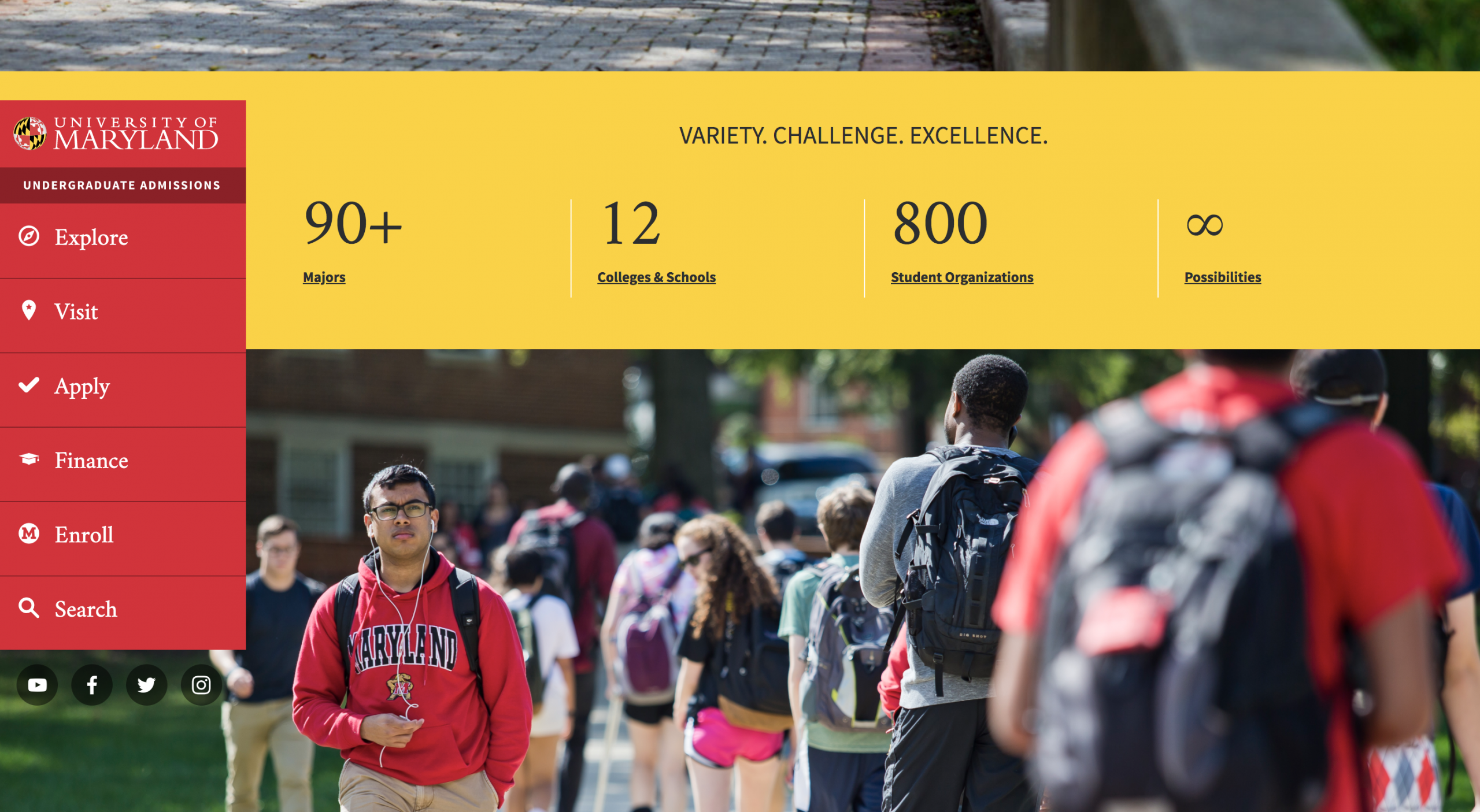Take as many AP classes as you can, log all your volunteer hours and – if you can find the time – run for student body president.
These are tips students have heard time and again from their high school guidance counselors to enhance their college applications and hopefully secure a spot at their dream school. It’s these tips and the ultra-competitive environment students find themselves in that transform your average high schooler into savvy marketers.
But what happens when this power dynamic flips? Is it now the colleges and universities that need to worry about marketing themselves to their dream students?
Factors such as the Common Application have made it possible for students to cast a wider net. And not only are students applying to more schools, but schools are accepting more students. In 2017, the Pew Research Center found that more than half of colleges and universities accepted two-thirds of those who applied – a number that is only going to increase on an annual basis. This means each highly qualified applicant receives more acceptance letters and has their pick of the lot. To avoid such an influx of competitors, you should review the World University Ranking and make the right choice to increase your chances.
So – what’s the lesson for higher education? It’s time to embrace 21st-century digital marketing.
It’s a relatively new concept that schools can categorize themselves as “brands.” Sure, mascots and school colors have always existed (proud Tufts Jumbo right here), but how does an institution actually focus on its brand awareness and stand out from thousands of others out there? It starts with aligning your messaging across communication channels.
Fortunately for you, class is in session! Take a seat as we go over the top 5 higher education marketing strategies that work:
1. Experiential marketing
Being just another booth at this year’s college fair no longer does the trick. Your marketing plan should include face-to-face interactions with your audience. In-person events can be a great source of lead generation, helping you engage high school students at a critical point in their educational journey.
You can achieve this through experiential marketing by using such tactics as:
- Sharing VR goggles to show interested applicants around your campus.
- Hosting a “hackathon” for high school students interested in coding.
- Setting up shadowing programs so prospective students can follow college seniors with internships or even alumni at full-time jobs for a day.
And this audience interaction shouldn’t begin in just the junior or senior year of high school. Engaging with students at a younger age in unique ways establishes a stronger relationship with them earlier on – even a sense of “brand loyalty,” if you will. This can lead them to start thinking about the steps they need to take prior to enrollment with your institution.
While some of these in-person initiatives may be farther on the horizon due to current conditions, many can be translated to a digital platform. You can still provide VR campus tours and even host virtual “pop up events.” With extra time on their hands, prospective students will appreciate these unique ways to stay busy.

2. Personalized visual content
Young millennials, Generation Z and Generation Alpha make up the majority of your target audience as they set their sights on their academic future. As the prime “Netflix generations,” this demographic is accustomed to automated content curation based on their unique tastes and habits. Join in on breaking the one-size-fits-all cycle and personalize your marketing outreach to students.
Personalized higher ed marketing can take a variety of forms – it can be as simple as using marketing automation tools to address emails using a student’s first name. It can also go a little deeper, targeting students by interest. With strategic content marketing, lead capture forms and site tracking, you can gather information around a student’s intended major. From there, provide curated content that specifically fits each student’s interests.
The key to creating engaging curated content? Keep it visual. 66% of consumers today would prefer to watch a video about a product rather than reading about it. So why would it be any different for prospective students researching schools?
You can leverage videos in your:
- Admissions emails.
- Campus newsletter.
- Website (more on this in a bit).
- Social media (again, more to come).
The list is endless.
The best stories are those told directly by current students, adding to the personal brand factor. Once these powerful videos are combined with prospective student data is when your marketing strategy can really hit home.
Consider this: If a student’s site journey shows consistent views on your mechanical engineering page, it’s probably safe to assume that student’s interested in engineering courses. Enrolling them in a nurture email marketing campaign filled with videos of current engineering students showing off their cool new projects will be a double whammy.
3. User-friendly website
Nowadays, digital marketing strategies need a well-designed, intuitive website: 94% of a site visitor’s initial impression of a brand is based on its usability and appearance, according to Kinesis. In other words, a search engine optimized (SEO) website is one of your best marketing tools. While higher education websites are no exception to this rule – having a strong UI will always yield better results – there are specific enhancements you can use to elevate your website from just another university site to a true student experience.
Teenagers know what matters when shopping around for the right smartphone or pair of headphones. While buying new tech is by no means an equally weighted experience as choosing one’s academic future, some core elements do remain the same. New students need to know the basics – where’s the school located, how much does it cost, how many students attend, etc. Make this information easily available in a “Fast Facts” section. And the more transparent you can be with this information, the better. Students appreciate seeing specific dates and numbers when looking at a school’s start date or tuition. This will help them build trust in your institution and make for an easier decision-making process.
A blog is another must-have on every university website. But, to stand out, make sure your blog features personal student and campus stories. These can act as a kind of case study to help incoming students place themselves in the shoes of current students. Just remember to keep these short and visual – this is a chance to leverage those videos we spoke about earlier and keep lengthy text to a minimum. And you’ll need to update your blog often – if your content isn’t up-to-date and relevant, potential students will think the same about your school.

4. Authentic social media
Today’s younger generations see right through traditional marketing efforts – so you have to roll up your sleeves, get authentic and reach them on the social media platforms they use most. Most have used mobile devices their entire lives. If your school doesn’t already have a Snapchat or TikTok account, what are you waiting for? Enlist student workers to run these – not only will they know how to use the platforms best (and stay within university guidelines), they’ll also know how to create the fun and engaging content your prospective students are looking for.
Having such “brand ambassadors” or “influencers” for your school via social media will help prospective students feel connected to your campus in a modern way. Rather than hearing the dean or university president speak at them, they can follow a real student in real-time doing real college things, and engage with them along the way. Utilize other social media features such as live streams on Facebook or Instagram to create that personal feel. Viewers can ask questions, suggest topics for future streams and feel heard.
Social media is also a great way to keep the engagement train going with your prospective students and tie a variety of your marketing tactics together. If you’re dabbling in experiential marketing and hosting a pop-up (once we’re out of quarantine, that is), stream it on Instagram with a personable student host. Or ask a student who was featured in a popular testimonial video to do a social media takeover and give viewers a “day in the life” of their college experience. This is a great way to seamlessly bring together the pieces of your university story into one solid package and ultimately improve your conversion rates.
5. Top-notch customer service
For any brand, customer service plays a huge role. That’s why 96% of consumers quote customer service as an important factor in choosing where their brand loyalties will lie.
But how do higher education institutions capitalize on good customer service? Try these tactics:
- Online live chat feature: Hosting a live chat feature on your website allows students at all stages of their journey to get answers to their questions immediately by current students or admissions personnel. While live chat features can be a bit of a hassle to maintain, creating that personal touch helps students feel more confident in your school and their decision to attend.
- Break the mold of acceptance letters: When students are accepted to your school, do more than the typical letter (or email) with a “Congratulations!” on top. Send students a welcome package complete with school paraphernalia. You can even go a step further and make a social media campaign out of it. Include instructions in the package to have students post pictures of themselves with their new school gear and use a hashtag like “#SCHOOLNAMEbound” to drum up excitement.
- Accepted student groups and meetings: In that hectic month between students being accepted and their deadline to make a decision, help them engage with fellow acceptees as much as possible. Create a Facebook group for them to join, or even host meet-ups – even if they can only be virtual for now – across the country so students can share documents and feel your college’s sense of community right from the get-go. This is also an excellent way to involve active alumni from different regions. Plus, it helps make orientation a little less awkward!
Making your university into a marketable brand will always play a little differently than “traditional” marketing campaigns. Your audience isn’t buying a pair of shoes or renting a cleaning service – they’re making a life-changing decision that they’re equal parts excited and terrified about (OK – before I was a proud Tufts Jumbo, I was a nervous freshman Jumbo). Stay personable, stay nimble, and, most importantly, stay true to your U.
Want to stay up-to-date on marketing for higher education trends? Here are a few of our top picks for further reading:
Editor’s note: Updated October 2020.





